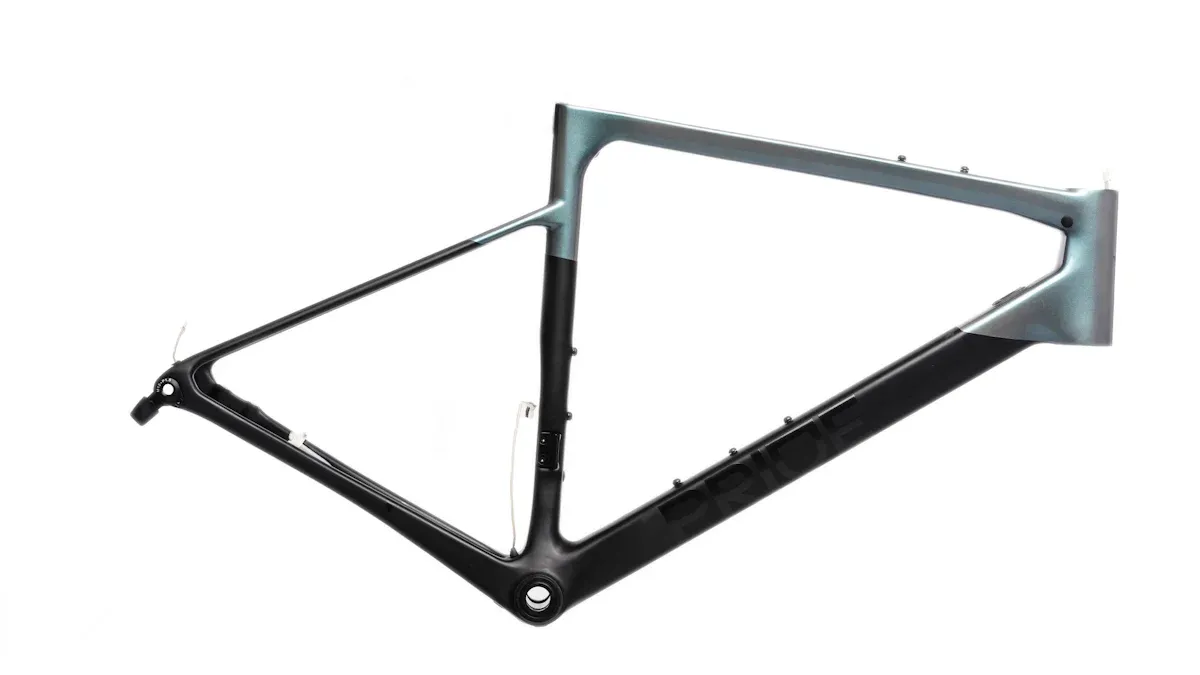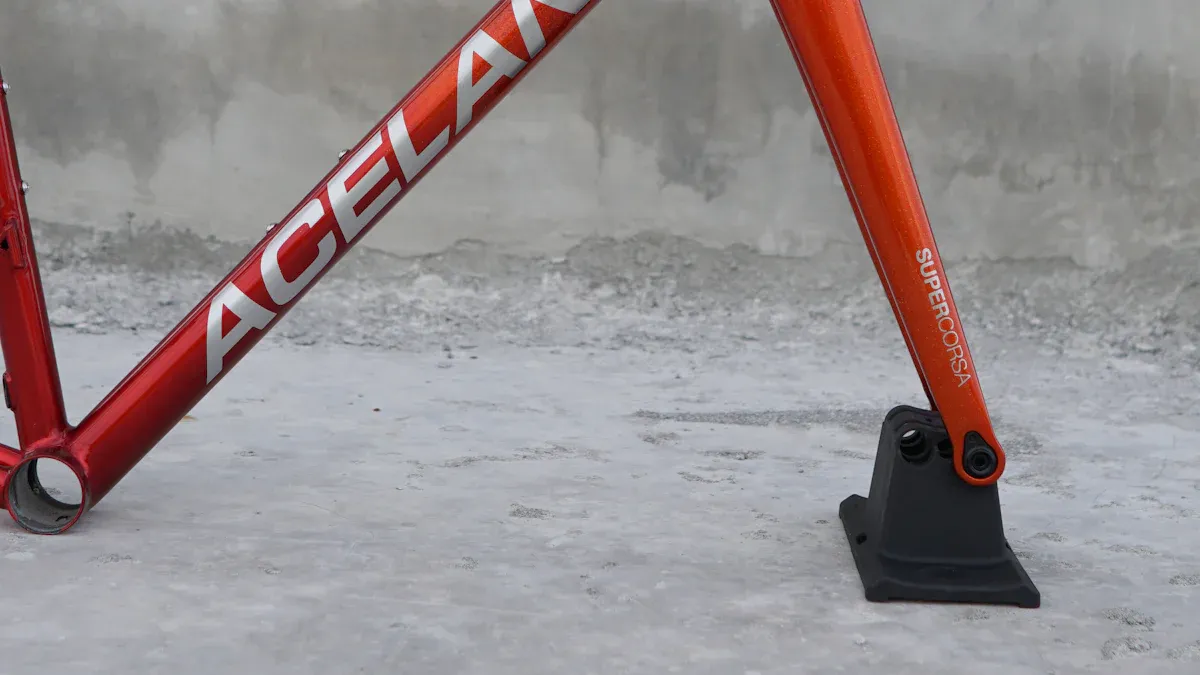
Choosing the right bike frame material affects how well you ride. Alloy bike frame materials, such as aluminum and titanium, have special benefits. These benefits fit different riding styles. Knowing about these materials helps you make smart choices. This leads to a better biking experience.
Key Takeaways
Picking the best bike frame material changes how you ride. Think about weight, strength, and comfort.
Aluminum frames are light and cheap but can break down faster than steel or titanium. They are good for fast rides.
Steel frames are strong and comfy, which makes them perfect for long rides. However, they are heavier and can rust if not taken care of.
Alloy Frame Characteristics

Aluminum Frames
Aluminum frames are very popular among bikers. They are light and strong. The most used alloy for bike frames is 6061 aluminum. This alloy is great because it balances weight, stiffness, and durability. It can reach a tensile strength of over 260 MPa and a yield strength of over 240 MPa. This strength helps you have a sturdy ride without being too heavy.
But aluminum frames have some downsides. They can wear out faster than other materials. This can cause problems over time. Usually, aluminum frames last about five years. After that, they might get softer and bendier, which can change how your bike rides.
Weight: Aluminum frames usually weigh 1.5 to 2 pounds more than carbon frames.
Power Requirement: You might need to use 7-10% more power to speed up on aluminum compared to lighter carbon frames.
Even with these issues, aluminum frames handle moisture better than steel. This makes them less likely to rust. They are also easier to fix than carbon fiber frames, which is a big plus for long-term use.
Steel Frames
Steel frames are known for being strong and comfortable. They give a smooth ride by soaking up road bumps well. This makes them good for many types of cycling, like commuting or touring.
Durability: Steel is tough and can handle daily use.
Comfort: Steel can bend a lot before breaking, giving a softer ride.
Repairability: Steel frames are easy to fix, which helps them last longer.
Steel frames usually have high Ultimate Tensile Strength (UTS) and Yield Strength. This strength allows for thinner tubes that still work well. While steel frames are often heavier than aluminum, some high-end steel can be lighter than certain titanium frames.
Titanium Frames
Titanium frames have a special mix of strength and lightness. They have a high strength-to-weight ratio, which helps with performance and handling.
Property | Effect on Ride Quality and Durability |
|---|---|
Light but strong, improving performance and handling. | |
Resistance to fatigue | Keeps its shape over time, ensuring it lasts long. |
Corrosion resistance | Stands up to tough weather without breaking down. |
Vibration-damping properties | Soaks up shocks, giving a smoother and more comfy ride. |
Longevity | Can last for many years, making it a good long-term choice. |
Titanium does not rust, so it needs very little care. This, along with its strength, makes titanium frames a great option for long-term use.
Carbon Fiber Frames
Carbon fiber frames are super light, which helps with speed and quick moves. They are known for being stiff, which improves power transfer and responsiveness.
Weight: Carbon fiber frames are some of the lightest, allowing for faster rides.
Stiffness: The stiffness of carbon fiber helps with power transfer, making pedaling easier.
Vibration Damping: Carbon fiber naturally absorbs small bumps and vibrations, making rides less tiring.
Feature | Carbon Fiber | Steel | Aluminum |
|---|---|---|---|
Tensile Strength | 500-700 MPa | ~400 MPa | ~300 MPa |
Stiffness | 40+ Msi | N/A | N/A |
How carbon fiber frames are made also affects how they perform. The type of carbon fiber and how it is arranged can change the frame’s strength and stiffness. Using less resin in the mix makes the bike frame lighter and better overall.
Pros and Cons of Bike Frame Materials

Advantages of Aluminum
Aluminum frames have many good points that make them popular with cyclists:
Lightweight: Aluminum is one of the lightest metals for bike frames. This makes it easier to handle your bike, especially when going uphill or speeding up.
Strength-to-weight ratio: Aluminum is strong and durable while still being light. This helps you enjoy a quick ride.
Corrosion resistance: Aluminum frames do not rust, so they work well in different weather. You can ride with confidence, knowing your bike can handle moisture.
Affordability: Aluminum frames usually cost less than carbon fiber ones. They give great performance without costing too much.
Versatility in design: Aluminum can be shaped in many ways, allowing for frames that are good for different cycling styles.
Low maintenance: Aluminum needs less care than other materials, making it a smart choice for everyday riders.
Quick acceleration: The light weight of aluminum helps you speed up faster and reach higher average speeds.
Disadvantages of Aluminum
Even though aluminum frames have many benefits, they also have some downsides:
Ride harshness: Aluminum frames can feel rough because they are stiff. This stiffness means less shock absorption on bumpy roads.
Fatigue life: Aluminum wears out faster than other materials. After about five years, aluminum frames may get softer and bendier, which affects how long they last.
Repairability: While aluminum frames are easier to fix than carbon fiber, small problems can turn into big repair costs if not fixed quickly.
Advantages of Steel
Steel bike frames have their own special benefits:
Durability: Steel is strong and can handle daily use. It resists damage, making it great for long rides.
Comfort: Steel frames soak up bumps well, giving a smooth ride. This is especially nice for long trips.
Repairability: Steel frames are easy to fix, which helps them last longer. If they get damaged, repairs are usually simple and not too expensive.
Disadvantages of Steel
Despite their good points, steel frames have some drawbacks:
Weight: Steel is heavier than aluminum and carbon fiber. This can be a problem for racing, needing more fitness and stamina from you.
Corrosion: Steel frames can rust, especially in wet areas. You need to take care of them regularly to stop rust.
Advantages of Titanium
Titanium frames have several attractive features:
Longevity: Titanium frames can last many years, making them a smart long-term choice. Most brands even offer lifetime warranties against defects.
Flexibility: Titanium is twice as flexible as steel, so it can bend without breaking. This flexibility makes for a comfy ride.
Corrosion resistance: Like aluminum, titanium does not rust and needs little care.
Disadvantages of Titanium
However, titanium frames also have some downsides:
Cost: Titanium frames often cost more than aluminum and steel. This high price can make them hard to get for some cyclists.
Repair challenges: Fixing titanium frames can be tough and expensive. You often need special tools and skilled help, which might not be available at all bike shops.
Advantages of Carbon Fiber
Carbon fiber frames are liked for their performance benefits:
Lightweight: Carbon fiber is one of the lightest materials, helping with faster acceleration and better agility.
Vibration damping: Carbon fiber absorbs vibrations, making long rides more comfortable.
Aerodynamics: The shape of carbon fiber frames often cuts down wind resistance, which is important for racing.
Disadvantages of Carbon Fiber
Even with their benefits, carbon fiber frames have some limits:
Complex stress calculations: Carbon fiber is strong but has weak shear strength. This means it needs careful calculations during making.
Difficult to change size: Once made, changing the size of a carbon fiber frame is hard, limiting customization.
Aging: The resin in carbon fiber can break down over time, especially in sunlight, leading to a slow loss of strength.
Expensive: Making carbon fiber frames takes a lot of work, making them cost more than aluminum and steel.
Choosing the Right Bike Frame Material
When picking a bike frame material, think about some important things. Each thing can really change how you ride and how happy you are with your bike.
Factors to Consider
Weight: The frame’s weight affects how you perform. Light materials like titanium and aluminum are best for speed. Heavier materials can slow you down, especially when climbing.
Purpose: Think about how you will use your bike. If you race, you need light and stiff materials. For touring, being strong is more important.
Riding Area: Consider where you ride. If you live in a wet area, aluminum is better than steel, which can rust.
Time of Use: How long it lasts matters. Steel is strong but can rust fast. Aluminum works well in wet weather and lasts longer.
Budget: Your budget is very important. Steel frames are the cheapest, while titanium frames cost the most. Aluminum and carbon fiber are in the middle.
Riding Style
Your riding style affects your choice of frame material. Here are some things to think about for different types of cycling:
Road Racing: For road racing, you want a carbon fiber bike frame. Carbon is efficient and responsive, which is key for racing. Its stiffness helps with power transfer, so you can pedal better.
Mountain Biking: Aluminum frames are popular for mountain biking because they are strong and light. They handle rough conditions better than carbon frames, which can get damaged easily.
General Use: If you ride for fun or commuting, steel frames are durable and comfy. They soak up bumps well, making your ride smoother.
Material | Characteristics | Preferred Use |
|---|---|---|
Aluminum | Light, stiff, can be butted for strength | Road racing, mountain biking |
Carbon | Lightweight, efficient, responsive | Road racing |
Steel | Durable, heavier | General use |
Choosing the right material for your riding style helps you get the best performance and comfort from your bike.
Budget Considerations
Your budget will greatly affect your choice of bike frame material. Here’s a quick look:
Steel: Usually the cheapest choice. It is strong and comfy but heavier.
Aluminum: Mid-range price. It has a good mix of weight, strength, and cost.
Carbon Fiber: More expensive because of how it is made. It gives great performance but may not fit every budget.
Titanium: The most expensive choice. It is strong and light but costs a lot.
By knowing these factors, you can make a smart choice that fits your riding style and budget. Whether you go for a mixed-material bike frame or stick with one type, understanding what to look for will make your cycling better.
Picking the right bike frame material is very important for how you ride. Think about things like how long it lasts, how easy it is to fix, and how it handles different weather. For instance, steel frames are very strong and easy to repair, which helps save money on maintenance over time. Choose based on your riding style and budget to make your biking experience better.
Frame Material | Durability Impact | Repairability | Environmental Susceptibility |
|---|---|---|---|
Aluminum Alloy | Lower strength, more likely to break | Moderate | Resists rust but can oxidize |
Steel | Very durable, easy to fix | High | Less likely to get damaged in tough weather |
FAQ
What are the main benefits of carbon fiber bike frames?
Carbon fiber frames are very light and stiff. They soak up vibrations well. This helps with speed and comfort. They are great for racing and long rides.
How does carbon fiber compare to aluminum frames?
Carbon fiber is lighter and stiffer than aluminum. It gives better power transfer but usually costs more.
Are carbon fiber frames durable?
Yes, carbon fiber frames are strong but can break if hit hard. Taking care of them helps keep their strength over time.
See Also
Understanding Bike Frame Materials: Carbon, Aluminum, And Steel
Comparing Enduro Bike Frame Materials For Durability And Strength
Evaluating The Durability Of Aluminum Bike Frames: Pros And Cons
Discovering The Lightest Bike Frame Materials Available Today
Essential Materials For Track Bike Frames And Their Importance
